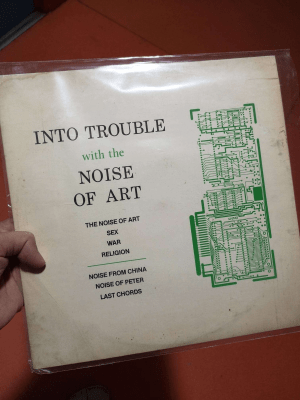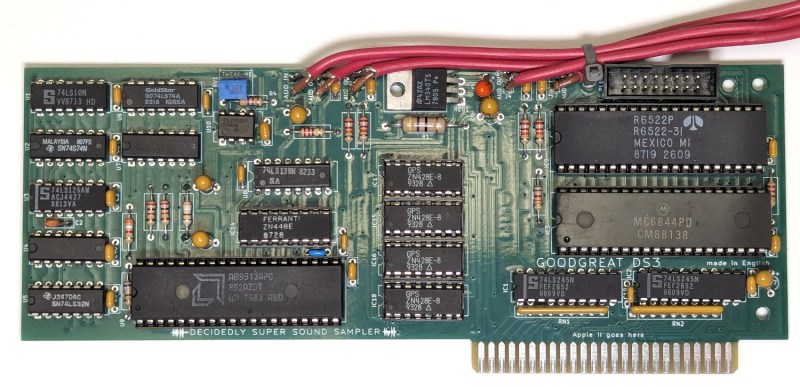[Bea Thurman] had a retro music conundrum. She loved the classic Greengate DS:3 sampler, but couldn’t buy one, and couldn’t find enough information to build her own. [Bea’s] plea for help caught the attention of [Eric Schlaepfer], aka [TubeTime]. The collaboration that followed ultimately solved a decades-old mystery.
In the 1980s, there were two types of musicians: Those who could afford a Fairlight CMI and everyone else. If you were an Apple II owner, the solution was a Greengate DS:3. The DS:3 was a music keyboard and a sampler card for the Apple II+ (or better). The plug-in card was a bit mysterious, though. The cards were not very well documented, and only a few survive today. To make matters worse, some chips had part numbers sanded off. It was a bit of a mystery until [Bea and Tubetime] got involved.

While [Bea] didn’t have the card itself, she had a photo of the board and a picture of an album that contained the key to everything. The Greengate came packed with a vinyl album, “Into Trouble with the Noise of Art.” An apt title, since the album art was the Greengate PCB top layer. Now if you know [Eric], you know he wrote the book (literally) on taking things apart and taking photos of them, even producing replicas.
Thoroughly nerdsniped, [Eric] loaded the photos KiCad and started tracing. With the entire top layer artwork and most of the bottom layer, the 8-bit card wasn’t too hard to figure out. The sticky point was one chip. A big 40-pin part with the numbers scrubbed off. One owner pulled the chip to check for fab information on the back, only to be greeted by a proper British “You Nosey S.O.B.” penciled on top of more sanded part numbers.
If the chip was an ASIC, the project would be blocked until they could get their hands on an actual board for analysis. An ASIC would have custom part numbers on it from the fab though – no need for sanding. It had to be something off the shelf. [Eric] used some context clues to determine that the Mystery chip had to be a DMA controller. This narrowed the field down. From there, he had to compare pinouts until he had a match with the venerable MC6844.
With the mystery part out of the way, [Eric] put the finishing touches on the PCB, saved it to his GitHub as the GoodGreat DS:3, and sent it off. A few days later, the bare boards arrived and were quickly populated with vintage parts. [Eric] ran a few tests and sent the card off to [Bea], where we will pick up with part 2.
At least the device wasn’t protected with a self-destruct code.















It seems like they wanted to keep their secrets – scraping off part numbers – but then why did they choose to show the entire top artwork on the album cover?
If you have the board already, then the layout isn’t a secret – it’s right there in front of you. But you still can’t clone it unless you know the parts.
I don’t think the “self-destruct code” article is a good one to reference back to, at least like this.
It was far more like glitch/mistake that bricked it.
great story!
The album title was a cheeky play on the “into battle with the art of noise” album, to suggest you could do similar stuff as the Fairlight.
Heavily used on the “Tennants of the latticework” album by the band Mainframe.
Was this the sampler used by ‘The KLF ‘ when they were ‘The JAMMs’ ? Some articles mention them having an ‘Apple II’ computer with a ‘ sampler card’, which they used on their albums ‘1987’ and ‘Shag Times’.
It was, yes! George Michael also used one on I Want Your Sex, and Queen had one for touring
The system looked a bit flaky for touring, I would have thought it would be unreliable, not having the robust construction of professional sound equipment, the setup was designed just to stay put on a desktop, from seeing the review of it from ‘Electronics & Music Maker ‘ from 1984. The later Akai Sampler, which the KLF went on to use , was a lot more professional, Akai are still making samplers today.
Interesting – a Greengate DS:4 rack unit with card which I think is a lot rarer sold recently on ebay in the UK for £410. I would have liked it but it was too much for me. There are a few others out there but far fewer, it seems the DS:4 bankrupted the company.
Fascinating stuff – does this image on the article here (Muzines / Electronic Music Maker & Computer Music, 1984) show that the mystery chip was a MC36848C? Or is that a different one, already known about?
https://www.muzines.co.uk/articles/behind-the-greengate/3413
I was the software manager at Fairlight back in the day working on the yet to be release Series III CMI. A very young English guy comes into our offices for an interview for a position as a software engineer. So obviously I asked him what relevant experience he had. He said “I wrote the software for a sampler called Greengate”. True story. He subsequently worked for Fairlight for several years on one of the first non-destructive audio editing systems pioneered by Fairlight. Later in his career he ended up with a very senior R&D position at Dolby. We are still in contact.